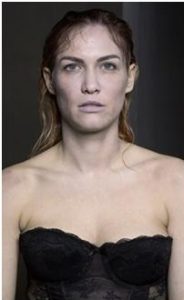One thing that has struck me about trying to gain an academic understanding of the role photography plays in the online transaction of sex is how dismissive prohibitionists are of photography, and the role photography plays in encouraging the sense that the only way of interpreting their lives is to see them as ripe for ‘rescue.’ Prohibitionist photography acts as a self-fulfilling prophecy. The anti sex work lobby creates the visual rescue narrative that gives legitimacy to saving sex workers from themselves.
Whoretography (www.whoretography.com) sits nicely at the intersection of imagery, technologies, society & the sex worker rights movement, and no discussion of sex worker visual representation is complete without understanding the way prohibitionists wield photography as a weapon in the prohibitionist war on sex work.
You see, to believe the prohibitionist lobby is to believe in the irrelevance of photography to the sex work debate. The only photographic truth is the prohibitionist photographic truth, and it’s been my experience that prohibitionists are quick to tow the visual party line. They are dismissive of Whoretography and the relevance of photography to the sex work debate. A much tried and tested prohibitionist tactic is to label anyone critiquing prohibition photography as nothing more than laziness and nitpicking. If you want evidence of such, just see the vitriolic language directed at sex workers for calling out prohibitionist imagery.
Gonzalo Arévalo’s work has all the hallmarks of anti-sex-work visual rhetoric. It accompanied an article on marital infidelity; It is a brilliant example of visual propaganda from a powerful anti-sex work lobby who dismiss the importance of sex work visual depictions. Are we to believe that illustrations do not matter? That their carefully crafted image choice is not part of a visual war raging against sex workers? To quote the prohibitionists, I am not buying it.

Copyright Gonzalo Arévalo
The French anti prostitution organisation Mouvement du Nid, created a fake escort website (http://girlsofparadise.sex) with the aim of deterring men from paying for sex. The site a perfect example of why the dead whore is such a powerful visual marketing tool. Mouvement du Nid argue they are fighting violence against sex workers by using violent images, completely oblivious and ignorant to the way photography gives justification to the violence Mouvement du Nid claim to want to stop. So ignorant, they celebrated upon being awarded a prestigious advertising award for doing nothing more than promoting a stereotype. For an organisation that purports to save sex workers, an image of a dead prostitute is essential for bringing in cash donations.

Copyright Mouvement du Nid
The Salvation Army also understands the financial benefits of maintaining the visual status quo. They were forced to make a public apology after sex workers complained over the representation that vilified them as bad mothers. Although the Salvation Army issued an apology over the offensive material, other campaigns that visually depict sex worker as hapless deviants continue to form part of their fund raising strategy.

Copyright The Salvation Army
These photographs above encapsulate the formulaic prohibitionist approach to the visual representation of sex work. Dark alley, street walker leaning into the car, robotic fallen woman robbed of agency, distressed child, always unseen predatory male, bad mother, battered corpse. A sense of desperation and the wafting smell of cocaine, heroin, lube and baby oil hangs heavy in the cinematic tones. The prohibitionist lobby argues that to discuss sex work photography is just laziness, that photographs do not matter and if this is the case, then it is a remarkable coincidence that the above photographs taken from prohibitionist websites epitomise stigmatising rhetoric.
The majority of articles written about sex work are accompanied by a picture of outdoor sex work, regardless if the written words discuss indoor sex work. The media portrayal of sex work is just as lazy as the prohibitionists. Going to a stock photo agency website and typing prostitution hardly makes one a photo editor. On the other hand, if you believe photography matters to the war on sex then one may argue the anti lobby image selection is inspired and to be admired. After all, if I were a former sex worker (as some high profile prohibitionists are) seeking to align myself with the other side of the virgin/whore dichotomy, I would have chosen these picture as well.
This prohibitionist attitude towards photography is not uncommon, nor is their denial that the camera is an agent of violence wielded against sex workers. To talk about sex worker imagery is just nit-picking. A standard reaction from those who do not understand the photographic theory, visual identity and that photography is inextricably interwoven into sex work identities, narratives, and society.
At times, I believe prohibitionists are not aware they are perpetuating visual rhetoric; they suffer from a false photography consciousness. So in awe of their visual rhetoric, they believe it to be the truth. Denial is handy if you seek to indoctrinate people with exclusionary feminist visual violence. A well-lit and well-edited photograph makes the rescue narrative hard to sell. Prohibitionists are not immune to the use of Adobe software. Gonzalo Arévalo’s illustration is an example of this. Prohibitionists often argue that airbrushing and photoshop have gentrified sex work. However, if Photoshop has edited out the lower class reality of sex work, then they need only to present unedited photographs to show the class narrative that sex workers apparently remove via a Photoshop gentrification tool. If to talk about sex work photos is irrelevant, then why do prohibitionist use editing software? Why do they use photography at all?
If prohibitionists were honest, photographically speaking, they would acknowledge that what offends them the most is that the digital democratising of photography has robbed the middle-class masses of their control over photography and image dissemination. A photographic revolution has taken place, and sex workers are discouraged from participating in it. The Photo-shopped gentrification of sex work is an argument designed to keep sex workers away from the digital revolution. Through photography’s new found accessibility, sex workers now have access to an unfettered form of communication; they can now challenge social constructs about their lives. Sex workers are now image makers and it’s difficult for prohibitionists to control the visuals of sex work if sex workers themselves now have a photographic voice of their own. If war imagery has taught us anything, it’s that those who control the image also control the message and middle-class ladies who lunch cannot keep other women in line if they can’t control how wayward women are visually constructed.
It’s time prohibitionists were challenged on the social effects of the visual propaganda they circulate. Their lack of understanding of visual culture is matched only by their insistence that illustrations do not matter. They wilfully label photography as irrelevant to the sex workers rights debate and maliciously, perhaps dangerously, they seek to use photography to silence the voices, intentions, actions, feelings and the rights of sex workers.
Biography –
Camille Melissa is a Documentary Photographer, Masters Student, Sex Worker and Visual Activist interested in using photography to challenge the victim centred nature of sex worker imagery and how photography is instrumental in the war against sex workers. Through Whoretography, she is challenging the prevailing ideology of sex-work and wants to present to the viewer an alternative perception of the industry and participants – frequently obscured by one particular, narrow version of feminism, by anti-sex-work rhetoric and by modern Western cultural attitudes towards bodies and sex. Her photographic and cyber ethnographic work is about stopping the over-simplification of the lives of sex workers, and to challenge current imagery that encourages the sense that the only way of interpreting their lives is to see them as ripe for ‘rescue.’ Through Whoretography, Camille is working on a new interpretation of sex work imagery that will help to change the visual landscape that informs political views that rob so many sex workers of autonomy. She is currently publishing a series of books and e-magazines and is working towards secure funding to establish the first and only publishing house dedicated to using the visual medium of photo books to advance the rights of sex workers. She holds a Bachelor’s Degree in biological sciences, postgraduate in criminology and is undertaking a Masters’s Degree in digital photography.
Please note all our blogs are the views of the author and do not necessarily represent the views of the Beyond the Gaze Team.
